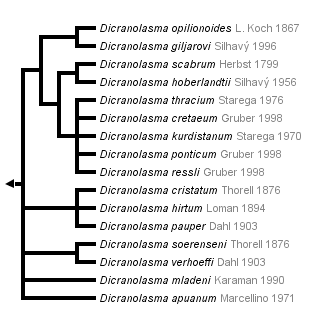Dicranolasmatidae
Dicranolasma
Axel Schönhofer


This tree diagram shows the relationships between several groups of organisms.
The root of the current tree connects the organisms featured in this tree to their containing group and the rest of the Tree of Life. The basal branching point in the tree represents the ancestor of the other groups in the tree. This ancestor diversified over time into several descendent subgroups, which are represented as internal nodes and terminal taxa to the right.

You can click on the root to travel down the Tree of Life all the way to the root of all Life, and you can click on the names of descendent subgroups to travel up the Tree of Life all the way to individual species.
For more information on ToL tree formatting, please see Interpreting the Tree or Classification. To learn more about phylogenetic trees, please visit our Phylogenetic Biology pages.
close boxThe tree is derived from interrelationships proposed by Gruber (1998) based on morphology.
Introduction
The monotypic Dicranolasmatidae comprise currently 16 species in the Western Palearctic with center of distribution in Italy, the Balkan Peninsula and to the Caucasus and Iran in the East. They are unmistakable given their bifurcate head cap covering the chelicerae with the eyes situated in the middle of the individual branches. Body form is globular in contrast to the similar but predominantly flat Trogulidae and the number of tarsal segments are increased in comparison. They exhibit advanced soil crypsis, gluing large amounts of soil to their integument and fixed by elongated papillae, that accumulates to sometimes half the body height.
Taxonomy and Discussion of Phylogenetic Relationships
Dicranolasma is monophyletic and close sister to Trogulidae in all studies (e.g. Giribet et al. 2010; Schönhofer and Martens 2010) but seems to have an intermediate position between Trogulidae and Nemastomatidae, which is also apparent in the transient morphology (e.g. body form, head cap, soil crypsis, clavate hairs on palps, high count of tarsal segments). Genital morphological differences to Trogulidae are minor when compared to the diversity within the Nemastomatidae. Species delineation and relationships within the genus have been studied by Gruber (1974, 1998). In the widespread Dicranolasma soerenseni and D. opilionoides further cryptic species are to be expected, as is likely true for the still underexplored Asian distribution of the genus.
Ecology and Life History
Dicranolasma inhabits humid well structured soil habitats, often in combination with calcareous bedrock that is sheltered by forest. Adults can be found year-round. Many species enter caves frequently, yet cave adaption seems absent. Prey specialization on snails in Dicranolasma scabrum has been reported and is likely the case throughout the genus.
References
Giribet, G., Vogt, L., Pérez-González, A., Sharma, P. and A. B. Kury. 2010. A multilocus approach to harvestman (Arachnida: Opiliones) phylogeny with emphasis on biogeography and the systematics of Laniatores. Cladistics 26:408-437.
Gruber, J. 1974. Ein Beitrag zur Systematik, Morphologie und Bionomie der Gattung Dicranolasma SØRENSEN (Arachnida: Opiliones). Dissertation philosophische Fakultät, Wien (unpublished).
Gruber, J. 1998. Beiträge zur Systematik der Gattung Dicranolasma (Arachnida: Opiliones, Dicranolasmatidae). I. Dicranolasma thracium STAREGA und verwandte Formen aus Südosteuropa und Südwestasien. Annalen des Naturhistorischen Museums in Wien 100B:489-537.
Schönhofer, A. L. and J. Martens. 2010. Hidden Mediterranean diversity: Assessing species taxa by molecular phylogeny within the opilionid family Trogulidae (Arachnida, Opiliones). Molecular Phylogenetics and Evolution 54(1):59-75.
Title Illustrations

| Scientific Name | Dicranolasma pauper |
|---|---|
| Specimen Condition | Live Specimen |
| Identified By | Axel Schoenhofer |
| Life Cycle Stage | adult |
| Copyright |
© 2011 Axel Schönhofer

|
| Scientific Name | Dicranolasma pauper |
|---|---|
| Specimen Condition | Live Specimen |
| Identified By | Axel Schoenhofer |
| Life Cycle Stage | adult |
| Copyright |
© 2011 Axel Schönhofer

|
| Scientific Name | Dicranolasma pauper |
|---|---|
| Specimen Condition | Live Specimen |
| Identified By | Axel Schoenhofer |
| Life Cycle Stage | adult |
| Copyright |
© 2011 Axel Schönhofer

|
About This Page
Many thanks to Angela DiDomenico for the final English check.
Axel Schönhofer

San Diego States University, San Diego, California, USA
Correspondence regarding this page should be directed to Axel Schönhofer at
Page copyright © 2012 Axel Schönhofer
 Page: Tree of Life
Dicranolasmatidae . Dicranolasma .
Authored by
Axel Schönhofer .
The TEXT of this page is licensed under the
Creative Commons Attribution-NonCommercial License - Version 3.0. Note that images and other media
featured on this page are each governed by their own license, and they may or may not be available
for reuse. Click on an image or a media link to access the media data window, which provides the
relevant licensing information. For the general terms and conditions of ToL material reuse and
redistribution, please see the Tree of Life Copyright
Policies.
Page: Tree of Life
Dicranolasmatidae . Dicranolasma .
Authored by
Axel Schönhofer .
The TEXT of this page is licensed under the
Creative Commons Attribution-NonCommercial License - Version 3.0. Note that images and other media
featured on this page are each governed by their own license, and they may or may not be available
for reuse. Click on an image or a media link to access the media data window, which provides the
relevant licensing information. For the general terms and conditions of ToL material reuse and
redistribution, please see the Tree of Life Copyright
Policies.
- First online 08 July 2012
- Content changed 08 July 2012
Citing this page:
Schönhofer , Axel. 2012. Dicranolasmatidae . Dicranolasma . Version 08 July 2012 (under construction). http://tolweb.org/Dicranolasma/145995/2012.07.08 in The Tree of Life Web Project, http://tolweb.org/





 Go to quick links
Go to quick search
Go to navigation for this section of the ToL site
Go to detailed links for the ToL site
Go to quick links
Go to quick search
Go to navigation for this section of the ToL site
Go to detailed links for the ToL site